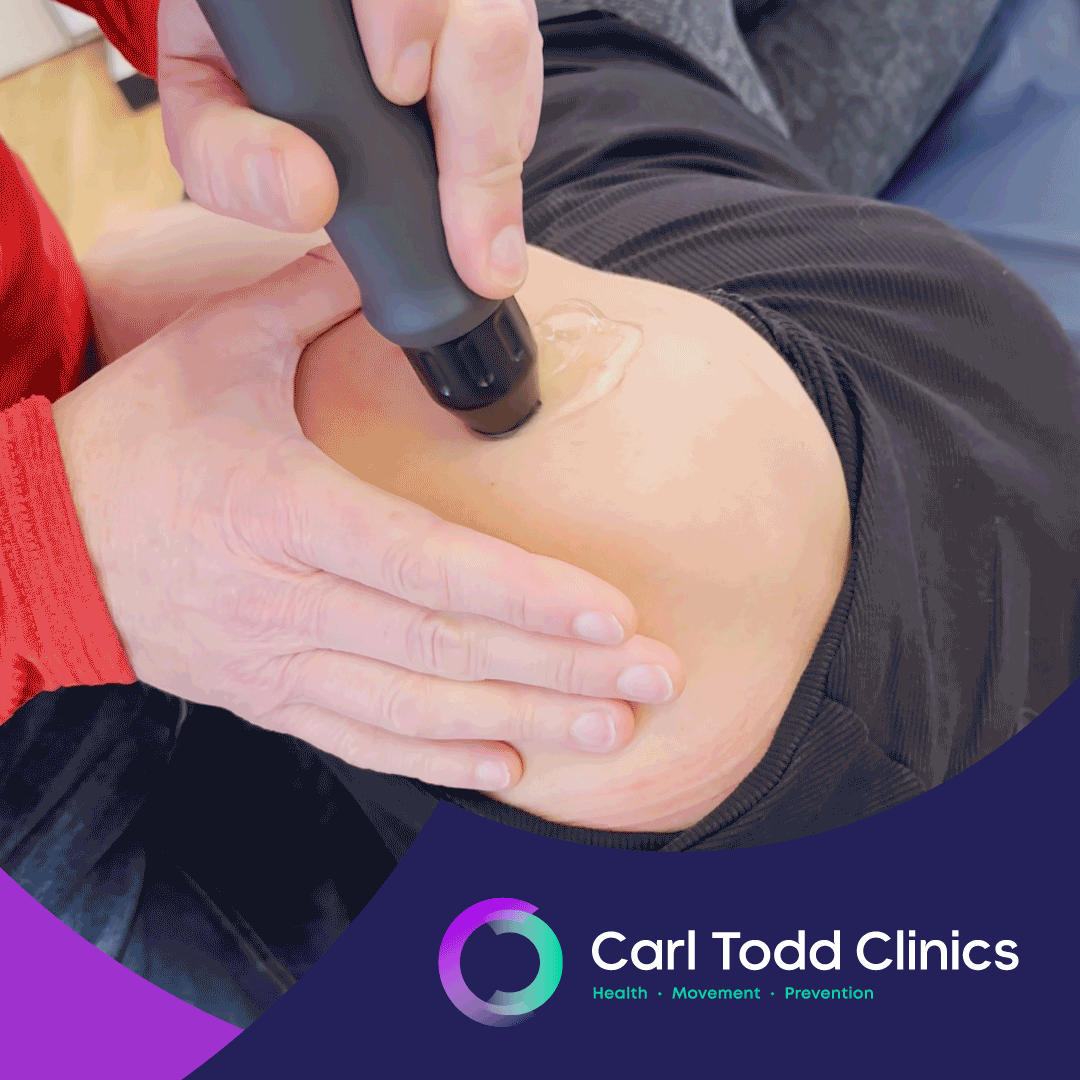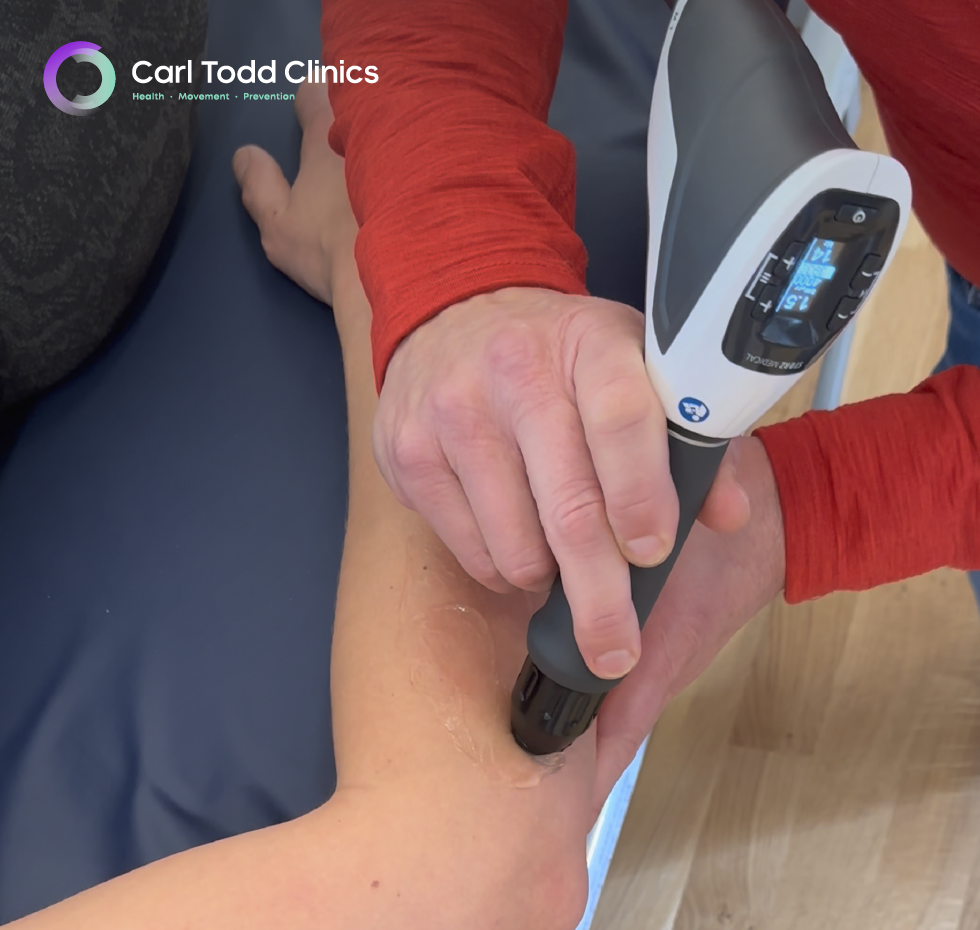Shockwave Therapy (ESWT)
If you have been suffering from tendon pain in your Achilles, knee, elbow, foot or shoulder for a long period of time and haven’t been able to find relief from various forms of treatment, Shockwave treatment may be of benefit.
What is Shockwave Therapy?
Shockwave Therapy (ESWT) is a non-invasive treatment performed with a hand-held device that creates high-energy sound waves (or pressure waves), transmitted to the injured tissue. The shockwaves are mechanical waves, not electrical ones, thought to work by increasing blood flow to the area, promoting cell regeneration, and reducing pain.
It’s often used as a treatment for chronic pain conditions that haven’t responded to other conservative measures like physical therapy or medication. Shockwave treatment was originally developed to break up kidney stones without surgery, and has since been utilised in various medical fields, including orthopaedics, sports medicine, urology, and rehabilitation.

How does Shockwave Therapy work?
Shockwave treatment utilises focused sound waves to jumpstart the healing process in your body’s soft tissues. It initiates an inflammation-like condition (pro-flammatory) in the tissue that is being treated and the body responds by increasing the blood circulation and metabolism in the area, which in turn accelerates the body’s own healing process and stimulates cell regeneration.
Shockwave Therapy for non-invasive pain relief
Treatment by Shockwave Therapy is indeed a great option for non-invasive pain relief! Long term injuries that haven’t responded to normal treatments are often considered for steroid injections or surgery. Shockwave Therapy offers potential where other therapies have failed. It can also help calcifications and improve pain and range of movement in frozen shoulder.
Here’s why it stands out for chronic pain management:
Targets the source of pain: Shockwave Therapy goes beyond just masking pain. It targets the underlying tissue injury by stimulating healing and regeneration.
Non-invasive and drug-free: Unlike medications that can have various side effects, Shockwave Therapy is a non-invasive procedure that avoids any type of needle or incision.
Effective for chronic conditions: When other conservative measures haven’t provided relief, Shockwave Therapy can be a game-changer for chronic pain in tendons, ligaments, and muscles.
Improves blood flow: Shockwave treatment increases blood flow to the injured area, which accelerates healing and delivers essential nutrients for repair.
Potential for long-term relief: By promoting tissue regeneration, Shockwave Therapy can offer long-lasting pain relief and improved function.
Shockwave Therapy can be used to treat a wide variety of musculoskeletal conditions
- Tennis/golfer's elbow
- Knee ligament sprain
- Shoulder Calcific Tendonosis
- Achilles Tendonosis
- Plantar Fasciitis
- Stress factors

The success rate of Shockwave Therapy
Documented international results show an overall result rate of 77% of chronic conditions that have not been cured with other kinds of treatment. Conditions like plantar fasciitis, Achilles tendinitis, and some types of shoulder tendinitis also show significant improvement with Shockwave Therapy. Studies report up to 80% improvement in some cases!
It is important to highlight that we would expect positive clinical outcomes following treatment, however there is a chance that the treatment may not improve your symptoms. A review at 12 weeks is recommended following your final treatment. If at this stage your symptoms persist you will be advised of alternative treatments/surgery by your medical practitioner.
The advantages of Shockwave Therapy
ESWT treatment stimulates and effectively supports the body’s self-healing mechanisms. It is usual to experience immediate pain relief following the treatment and hence improved movement. Reported side effects are minimal.
However, there may be some discomfort during treatment, skin reddening, possible bruising.
After seeing around 6 different people over the past 3 years I was referred to Paul Tuffs by Carl Todd for my leg problems. Paul has done what no one else has done and helped me back running. I highly recommend both Carl and Paul and can’t thank them enough. 1st class service
Read the review
You will not find anyone better!! I have been seeing Carl for near on 20 years now and wouldn't go anywhere else. His knowledge never fails to amaze me and every injury I have ever had Carl has manage to sort. Highly recommended.
Read the review
Recent treatments with Elly have made my life much better. Such a lovely professional service from reception to practitioner. Kind, friendly, knowledgeable and most of all welcoming.Great value for your money and appointments available at short notice. Thank you so much.
Read the review
What are the side effects of Shockwave Therapy?
Shockwave therapy is generally considered a safe and well-tolerated procedure! However, like any medical treatment, there can be some potential side effects. Shockwave Therapy side effects should be mild and temporary. If you’re experiencing severe or persistent side effects you should consult with your physiotherapist.
Many patients tolerate shockwave therapy well with minimal discomfort.
Common side effects:
Temporary pain or discomfort: You might experience some mild pain or soreness at the treatment site during or immediately after the procedure. This is usually temporary and subsides within a few hours.
Redness and swelling: The treated area may appear red and slightly swollen following the session. This is also temporary and typically resolves within a day or two.
Bruising: In some cases, mild bruising may occur at the treatment site. This isn’t a cause for concern and should fade within a few days.
Less common side effects:
Numbness: Temporary numbness in the treated area can occur in rare cases. This usually resolves within a few days.
Skin irritation: Some patients may experience minor skin irritation following the treatment.
Headache or dizziness: Headache or dizziness are uncommon side effects, but they can occur in some individuals.
Shockwave Therapy FAQs
Sometimes the treatment is a bit painful, but most people can stand these few intense minutes without medication. If pain does become apparent during treatment, there are adjustments that can be made to reduce the discomfort. However, having some pain during the treatment illustrates that shockwaves are having a positive effect.
You will normally experience a reduced level of pain or no pain at all immediately after the treatment, but a mild and diffused pain may occur a few hours later. This dull pain can last for a day or so.
ESWT initiates a pro-flammatory condition in the tissue that is being treated. If necessary, you may use ordinary prescription-free pain killers. Do not use antiinflammatory medication and do not use ice on the treated area as both will interfere with the body’s self healing abilities.
Even if you have no pain we strongly recommend that you refrain from intensive activities that stress the treated area for the next 48 hours after each treatment.
Even though the response to shockwave treatment normally is exceptionally good within a few weeks it may take several months before maximum effect is achieved. If after 3-4 months you still do not experience a pronounced improvement, surgery for example may be an alternative depending on your particular clinical picture.
Shockwave Therapy shows promise as a treatment for chronic pain in soft tissues like tendons, ligaments, and muscles. Studies show significant improvement for conditions like plantar fasciitis, Achilles tendinitis, and some types of shoulder tendinitis. Your age, overall health, and the severity of your condition can influence how well you respond to the therapy.
You should speak to us prior to your appointment to see if Shockwave Therapy is right for your specific condition. We can assess the potential benefits and discuss the likelihood of success based on your situation.
Generally, you can resume light exercise and daily activities following shockwave therapy. However, we typically recommend avoiding high-impact activities like running or heavy lifting for 24-48 hours after treatment. This allows for optimal healing.
Some mild soreness is possible after the procedure. Adjust your activity level based on how you feel and avoid pushing through pain. Your physical therapist will provide specific recommendations on exercise limitations and rehabilitation exercises following your treatment.


